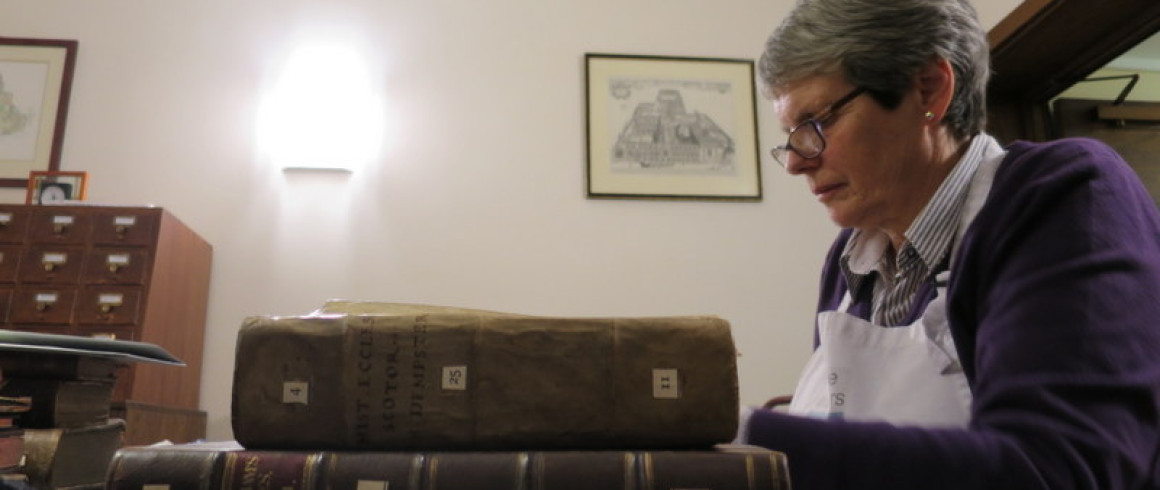Bookworms
The ‘NADFAS ladies’ are just one example of the work that goes on behind the scenes at Pembroke.
Jane, Mavis and Rosemary are all volunteers with the Cambridge branch of NADFAS – the National Association of Decorative & Fine Arts Societies. Although they are non-specialists, they have been trained by a professional conservator in how to look after for the books in our archives. Many of these tomes are centuries old and very fragile. It is essential that they are cleaned, dusted and cared for if they are to last for years to come.
Adorned in white aprons, the team enter the stacks underneath the library and load a shelf’s worth of books onto a trolley. Each book is given a numbered book mark to make extra sure that they find their way back into the right place on the shelf. Mavis, a former librarian, explains: ‘Sometimes there are books missing or because of their size they’re not arranged in strict numerical order.’
Once they’re brought back out onto the reading room table they can be cleaned. Usually volunteers work in pairs. One person is responsible for the exterior of the book, removing dust from the cover with a special (and rather noisy) vacuum cleaner. In some cases the book is too fragile even for the soft brush on the end of the nozzle and has to be dusted by hand. The second person then dusts inside the cover and the opening pages with a paintbrush. Jane explains: ‘It has to be a brush made of natural fibres. Some we use are paintbrushes, others are make-up brushes, but we all have our favourite ones.’
[/auto-gallery]
Are they ever tempted to read the books as they go? ‘Most of them are lengthy sermons in Latin and Greek, so not too often. But occasionally something will catch your eye.’ Often it is the annotations that are the most interesting: signatures, inscriptions, annotations and unrelated notes are scrawled onto the cover sheet or in the margins around the text.
Just the act of opening the books gives the ladies the chance to check their condition. Although they are not able to repair the books, they can look for signs of mould or even ‘bookworm holes’. If the binding is coming loose, a particularly common problem with books that have been rebound, they tie them with cotton tape to help support them and make them look neat. It’s a delicate task as the bows have to be positioned so that they don’t cause more strain to the covers.
‘Some of the books are in such a state that I’m almost afraid to touch them,’ says Mavis. It’s also a long job. Over the course of a morning, they might manage three shelves. They’re rightly proud that since the summer they’ve covered several bookcases, but there’s still a long way to go.
Nonetheless, the process of protecting these books it is very satisfying. Jane says: ‘It makes such a difference to the books. And for us there’s a real satisfaction in it. You feel like you are doing something really worthwhile. I think it is just important that someone is caring for the books, opening the and maybe even reading them. At one point they would have been very much loved, as most of these books would have originally formed part of an individual’s library. That’s what we’re doing: making sure that the books are still loved.’
For more information about Cambridge Decorative and Fine Arts Society, a member society of NADFAS, please see their website.









